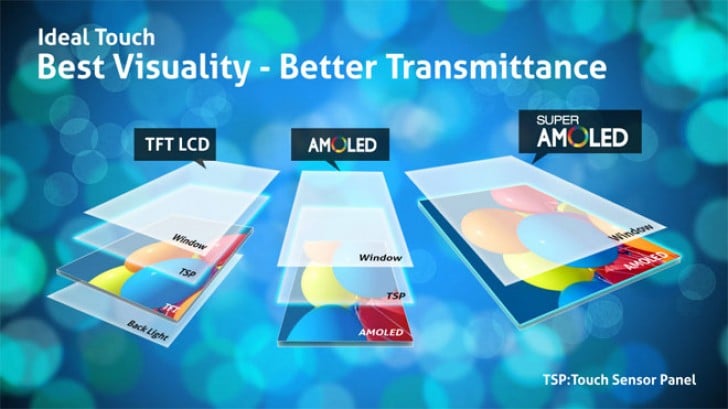Definition of Super AMOLED. S-AMOLED (Active-matrix organic light-emitting diode Display) is a marketing term that refers to a display technology used by a variety of electronic devices. The “super” in its name distinguishes it from its older and less advanced versions (OLED and AMOLED).
S-AMOLED could also be called super-amorphous organic light-emitting diode, or super-amorphous OLED because it uses amorphous silicon technology.
Two words on OLED and AMOLED
Displays that use organic light-emitting diodes (OLEDs) incorporate organic materials that light up in contact with electricity. The active matrix aspect of AMOLED distinguishes it from OLED. AMOLED, therefore, is a type of screen technology that includes not only a way to visualize the light but also a method to detect touch (the “active matrix” part). While it is true that this method is also part of the AMOLED displays, the super AMOLEDs are slightly different.
Here is a brief summary of some pros and cons of AMOLED displays.
Pro
- Wide viewing angles
- Support of a wide range of colors
- Long battery life if you use darker colors
Versus
- Images too saturated
- Reduced battery life when viewing bright colors
The AMOLED displays are known to be able to make an intense black color when needed, a huge advantage on any display and something you will immediately notice when you compare it with your standard IPS (airplane switching) LCD (liquid crystal display). The advantage is evident when watching a movie or looking at an image that should contain “real” black.
AMOLED technology includes a layer behind the OLED panel that gives light to each pixel instead of using a backlight as LCD displays do. Since each pixel can be colored as needed, pixels can be blacked out or turned off to create a true black instead of pixels that are blocked by light reception (as with LCD).
This also means that the AMOLED screens are perfect for displaying a wide range of colors; the contrast against whites is infinite (because blacks are absolute blacks). On the other hand, this extraordinary ability makes over-saturation of images easier.
Super AMOLED vs. AMOLED
AMOLED is similar to Super-AMOLED not only in the name but also in the function. In fact, Super-AMOLED is the same as AMOLED in every sense except one, but it’s the one except that makes the difference.
The two technologies are the same as the devices that use them can incorporate light and touch sensors so that the screen can be read and manipulated. The touch-sensing layer (called a digitizer or capacitive touchscreen), however, is incorporated directly into the screen in Super-AMOLED displays, while it is a completely separate layer at the top of the screen in AMOLED displays.
This may not seem like a big difference, but Super-AMOLED displays offer many advantages over AMOLED displays due to the way these layers are designed:
- The device may be thinner because display and touch technologies are on the same level.
- A higher contrast, in addition to the lack of empty space between the digitizer and the actual screen, produces a sharper and more vivid display.
- It is necessary to supply less energy to a Super AMOLED screen because it does not generate as much heat as older screen technologies. This is due, in part, to the fact that the pixels are effectively deactivated and therefore do not emit light / use energy when black is displayed.
- The screen is more sensitive to touch.
- Light reflection is reduced because there are not so many layers, which makes it easier to read outdoors in full light.
- A higher refresh rate allows for faster response times.
The production of the technology behind Super-AMOLED displays is however more expensive. Like most technology, this is likely to change as more manufacturers incorporate AMOLED into their televisions, smartphones and other devices.
Here are some other disadvantages of AMOLED technology:
- Organic materials eventually die, so AMOLED displays degrade faster than LEDs and LCDs. Even worse, the materials used to create the individual colors have a variable duration, causing a noticeable difference in the general uniformity when the colors fade (for example, blue OLED films do not last as long as red or green).
- The burn-in screen is AMOLED with risk due to the use of non-uniform pixels. This effect is aggravated when the blue colors become extinct and leave the colors red and green to resume play, leaving an impression over time. That being said, this problem does not affect displays with a large number of pixels per inch.
Super AMOLED display types
Some manufacturers have additional conditions for Super-AMOLED displays with specific features in their devices.
For example, HD Super-AMOLED is Samsung’s description of a Super-AMOLED display with a high definition resolution of 1280 × 720 or higher. Another is Motorola’s Super-AMOLED Advanced, which refers to brighter displays and higher resolution than Super-AMOLED screens.
These displays use a technology called PenTile to sharpen the pixels. Others include Super-AMOLED Plus, Super-AMOLED Plus HD, Super-AMOLED Full HD, and Super-AMOLED Quad HD.

